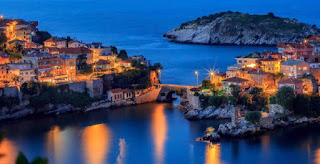The pipes, the pipes are calling....
The traditional way to heat a Turkish village house is by using a soba, essentially a tin box with a cylindrical bucket inside. You burn wood and coal in the bucket. But you have to be careful not to fall asleep with the soba full because the wind can change direction and you may wake up wearing a white kaftan and holding a harp.
A series of connecting pipes takes the smoke from the soba through an outside wall. The pipes spread the warmth through the building. The system works relatively well, especially if you have a load of spare wood. The downside is that once every winter your pipes need cleaning.
The dreaded day duly arrived and with the help of neighbour Huseyin and supervised by another neighbour, 80-year-old Ayşe Hanem we took down the Heath Robinson contraption. Inside we found the kind of build-up of soot and tar that surgeons might find in a 40-a-day smoker.
The usual solution is to wrap a sack around a stick and repeatedly push the stick up and down each section of pipe. That seemed like hard work to me, so I suggested to Huseyin that we might light a small fire inside each pipe and try to burn off the black gooey residue.
We had tried the idea on a couple of pipes when Ayşe Hanem arrived and suggested an even quicker method: benzine!
Eschewing all maternal warnings about playing with fire, Huseyin filled an empty plastic spray-topped bottle that once held cleaning fluid with petrol and coated the inside of each tube.
Then with the confidence often seen misplaced on many a You Tube video he lit a piece of paper and dropped it into one of the pipes. Whoosh. There was a dull, mini explosion and a plume of smoke.
But incredibly the method, doubtless forbidden in every health and safety manual, proved to be the most effective.
When the pipes cooled, I got to work with a wire brush and before you could say Chim, chimney, chim, chim, chim, chim, cher-ee.....the pipe was ready for re-assembly.
A series of connecting pipes takes the smoke from the soba through an outside wall. The pipes spread the warmth through the building. The system works relatively well, especially if you have a load of spare wood. The downside is that once every winter your pipes need cleaning.
The dreaded day duly arrived and with the help of neighbour Huseyin and supervised by another neighbour, 80-year-old Ayşe Hanem we took down the Heath Robinson contraption. Inside we found the kind of build-up of soot and tar that surgeons might find in a 40-a-day smoker.
The usual solution is to wrap a sack around a stick and repeatedly push the stick up and down each section of pipe. That seemed like hard work to me, so I suggested to Huseyin that we might light a small fire inside each pipe and try to burn off the black gooey residue.
We had tried the idea on a couple of pipes when Ayşe Hanem arrived and suggested an even quicker method: benzine!
Eschewing all maternal warnings about playing with fire, Huseyin filled an empty plastic spray-topped bottle that once held cleaning fluid with petrol and coated the inside of each tube.
Then with the confidence often seen misplaced on many a You Tube video he lit a piece of paper and dropped it into one of the pipes. Whoosh. There was a dull, mini explosion and a plume of smoke.
But incredibly the method, doubtless forbidden in every health and safety manual, proved to be the most effective.
When the pipes cooled, I got to work with a wire brush and before you could say Chim, chimney, chim, chim, chim, chim, cher-ee.....the pipe was ready for re-assembly.






Comments
Post a Comment